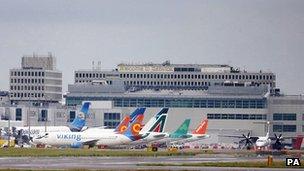Gatwick Airport to submit plan for second runway
- Published

Gatwick says a new runway could be "affordable and practical" but residents fear extra noise
Gatwick Airport bosses are to begin work on detailed plans for a second runway which would double annual capacity to 70 million passengers.
The West Sussex airport's owners say they will scrutinise the options to develop the site up to 2020 and beyond.
The plans will now be put to an independent aviation commission led by former Financial Services Authority boss Sir Howard Davies.
Campaigners fear expansion will raise noise levels and harm the environment.
Noise impact
Gatwick said no runway would be built before 2019 under a legal agreement signed in 1979.
Its bosses believe additional "capacity and flexibility" would help ensure London's airports provide south-east England with the connectivity needed.
Chief executive Stewart Wingate said it could be "affordable and practical" and a better option than new runways at Heathrow or Stansted airports.
"Over the last three years we have transformed the airport, invested around £650m and have a strong track record for delivering key routes to growth markets," he said.
"However, we must now look to the future when Gatwick will become full and outline its long-term role in ensuring London has an efficient and resilient airport system that creates the crucial connectivity London and the UK needs."
The plans sent to Sir Howard Davies's commission, which will report back in 2015, include evaluations of environmental and economic impacts.
Gatwick said its "masterplan" for the airport, external contained a "scenario" for a new runway. The plans were put to public consultation for 18 weeks, which ended in January, it said.
Gatwick serves 197 destinations and currently handles about 34 million passengers a year.
Residents living under the flight path fear a second runway would increase noise levels and cause air quality to deteriorate.
The Gatwick Area Conservation Group said hundreds of thousands of people across Surrey, Sussex and Kent would oppose a second runway.
'South East obsessed'
Chairman Brendon Sewill said: "We have always been totally opposed to a new runway on environmental grounds, and have had massive support from across Surrey, Sussex and west Kent.
"We have been supported by all the local MPs and all the county, district and parish councils in a wide area. If necessary, we will resume the battle."
Heathrow Airport said the UK was not short of "point-to-point" capacity provided by airports like Gatwick, Stansted, Birmingham and Luton.
"What the UK is short of is hub airport capacity," a spokesman said.
"Hub airports use transfer passengers to pool demand from different countries - and all the evidence suggests this is the only way to support the frequent and direct long-haul routes that are vital to business and trade."
In September, the government began a review of how the UK might expand its airport capacity in the South East.
The coalition said it was committed to pre-general election manifesto pledges that ruled out a third runway at Heathrow but some MPs argue that increased airport capacity is needed to help bring the UK out of recession.
London Mayor Boris Johnson, who opposes expanding Heathrow, has backed plans for an airport on an artificial island in the Thames Estuary, known as "Boris Island".
Architect Norman Foster has also proposed building a £50bn hub airport on the Isle of Grain.
Last month Liberal Democrat delegates voted against new runways at Heathrow, Gatwick or Stansted and against plans for a Thames Estuary airport at the party's conference in Brighton.
They branded aviation policy "South East obsessed" and suggested the Midlands would be a better location for a hub airport.
- Published16 October 2012
- Published14 May 2012
- Published18 January 2012
- Published20 October 2011